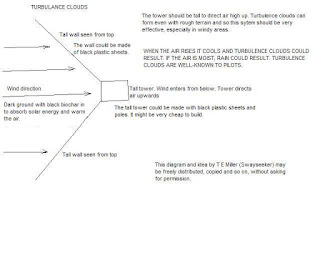2) From the Internet I read that the sea temperatures at Los Angeles in Jan and Feb are about 14.5 deg C. The average minimum air temperature for Los Angeles is about 9.2 deg C. At night, if one had a pipe inlet with a big collection area just above the sea the air temperature of the air coming into the pipe would be about 5 deg C warmer than the air temperature above the city. This means natural upwards convection of relatively warm moist sea air could occur in the pipe. If the pipe were coated with a low emissivity surface (shiny aluminium, etc) it would retain heat. It seems quite possible that convectional rain could occur with enough big pipes leading from the sea to over the city.
This idea might not work all of the time because air pressures over the sea and land might be different, but here are some points:. 1) The air just over the sea will be warmer and therefore less dense 2) The air from just over the sea will be moist and moist air is less dense. 3) For some periods it will work.
This calculation would be suitable for Cape Town: I use the Engineering Toolbox stack formula, with the following: A 20 m radius pipe (huge) Inside T of 14 deg C. Outside T of 8 deg C. This gives a flow rate of more than 1 cubic kilometre of air per 24 hour day, so the amount will be less, but it is a large volume of air.
3) If you look at the pdf called Pilot Exam Notes Meteorology on the internet you will see, on page 10, a discussion of turbulence clouds. Turbulence clouds can form when rough terrain funnels air upwards. As the air rises it cools and clouds can form. My system uses biochar to absorb solar energy and heat air and channels the air upwards. With even light wind and some sun rain could result.
The light portion of the solar energy passing through the greenhouse plastic will be absorbed by the black sheet instead of it penetrating deep into the ocean. The infrared portion of solar energy entering the greenhouse will be absorbed within the uppermost few centimetres of the sea surface. Any infrared radiation from the sea that is reflected back to the sea by the greenhouse plastic will also be absorbed in the upper few centimetres of the sea. The result will almost certainly be a heating of the sea surface under the greenhouse plastic, enhancing evaporation and high humidity. About 53% of solar energy is light energy, so the black sheet will prevent a lot of energy from escaping down to deeper levels and will concentrate it near the surface.
4) The wind speed is low just over the ocean (as it is just above the ground). There is therefore a fairly stagnant layer with very high relative humidity just above the sea. If one used thousands of floating devices as shown below one could increase moisture in the air so that air blowing to land would produce more rain. Water has a very high emissivity (about 0.95), so the greenhouse plastic will keep in a lot of radiation from the sea surface. For high sea surface temperatures of 30 deg C or so, the greenhouse will keep in about 450 W per square metre of infrared radiation from the sea surface.
The light portion of the solar energy passing through the greenhouse plastic will be absorbed by the black sheet instead of it penetrating deep into the ocean. The infrared portion of solar energy entering the greenhouse will be absorbed within the uppermost few centimetres of the sea surface. Any infrared radiation from the sea that is reflected back to the sea by the greenhouse plastic will also be absorbed in the upper few centimetres of the sea. The result will almost certainly be a heating of the sea surface under the greenhouse plastic, enhancing evaporation and high humidity. About 53% of solar energy is light energy, so the black sheet will prevent a lot of energy from escaping down to deeper levels and will concentrate it near the surface.


No comments:
Post a Comment